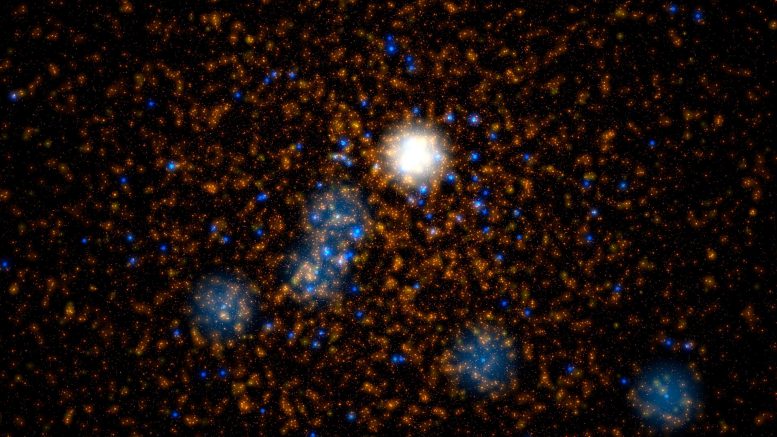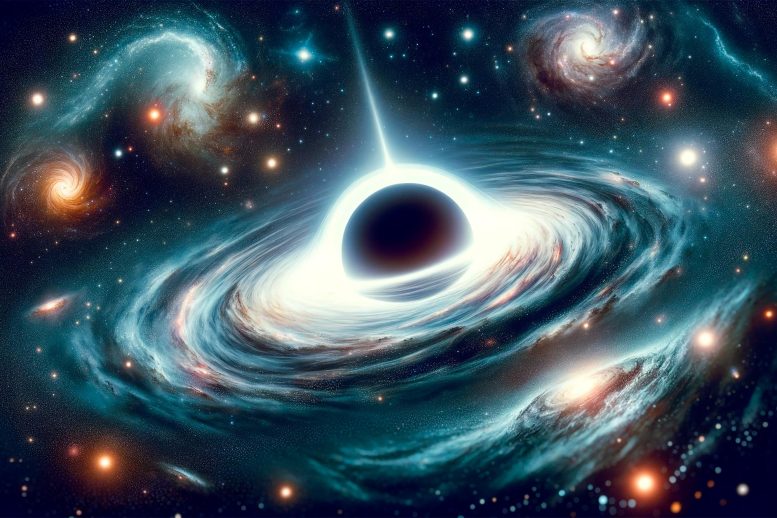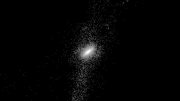Intermediate-Mass Black Holes (IMBHs) represent a cosmic puzzle, with their existence and formation mechanisms shrouded in mystery.
A recent study led by Gran Sasso Science Institute researcher Manuel Arca Sedda and published in Monthly Notices of the Royal Astronomical Society journal (MNRAS), sheds light on the mechanisms that lead to the formation of mysterious Intermediate-Mass Black Holes (IMBHs). These are objects with masses between a few hundred and tens of thousands of solar masses, which could represent the link between their smaller relatives, stellar black holes, and the supermassive giants that populate the centers of galaxies.
The Spectrum of Black Holes
Indeed, there are different types of black holes: although they share such high densities that even light cannot escape their gravitational pull, the mass of these celestial bodies can vary over a very wide range and discriminate their formation mechanism. We can identify three macro-categories of astronomical interest: stellar, intermediate, and supermassive.
The former, as the name suggests, are formed when a star of sufficiently large mass (i.e., at least twenty times more massive than our sun) exhausts its fuel and succumbs to the force of gravity by collapsing in on itself: they represent the lightest type of black hole, and we have a clear theoretical picture about the process leading to their formation.
At the opposite extreme are the immense supermassive black holes, with masses millions or billions of times greater than our star. Every galaxy is believed to host one at its center and in 2019, thanks to the Event Horizon Telescope, it was possible to obtain the first direct image of one of them.
Despite this formidable achievement, the formation and accretion of these objects still represent a fascinating mystery to modern astronomy, mainly due to the lack of a definitive smoking gun supporting the very existence of Intermediate-Mass Black Holes. And that is precisely the subject of Arca Sedda’s study, the first of two others currently under review.

The image depicts a simulated stellar cluster as computed in the Dragon-II simulations. Orange and yellow dots represent sunlike stars, while the blue dots indicate stars with masses of 20 to 300 times that of the Sun. The large white object in the center represents a star with a mass of about 350 solar masses, which will shortly collapse to form an intermediate-mass black hole. Credit: © M. Arca Sedda (GSSI)
The Elusive Intermediate-Mass Black Holes
“Intermediate-Mass Black Holes are difficult to observe,” explains the GSSI researcher, “the current observational limits do not allow us to say anything about the population of IMBHs with masses between 1,000 and 10,000 solar masses, and they also represent a headache for scientists in terms of the possible mechanisms that lead to their formation.”
One of the goals of the research was precisely to try to understand how these black holes form. “We have carried out new computer models that can simulate the formation of these mysterious objects, and we have found that such IMBHs can form in star clusters through a complex combination of three factors: mergers between stars much larger than our sun, accretion of stellar material onto stellar black holes, and, finally, mergers between stellar black holes. The latter is a process that results in the possibility to “see” these phenomena through the detection of gravitational waves,” Arca Sedda explains.
The study also hypothesizes what happens after intermediate black holes are born: they are thrown off their own clusters through complex gravitational interactions or due to a process known as relativistic recoil, thus preventing their further growth.
Zoom-in of a snapshot taken from one of the DRAGON-II simulations, modeling dense star clusters with up to 1 million stars. Orange and yellow dots represent sunlike stars, while the blue dots indicate stars with masses of 20 to 300 times that of the Sun. The large white object in the center represents a star with a mass of about 350 solar masses, which will shortly collapse to form an intermediate-mass black hole. Credit: M. Arca Sedda (GSSI)
“Our models show that although IMBH seeds form naturally from energetic stellar interactions in star clusters, they are unlikely to become heavier than a few hundred solar masses unless the parent cluster is extremely dense or massive,” the GSSI researcher says.
However, an important scientific mystery is yet to be answered: whether intermediate black holes represent the link between stellar and supermassive black holes. It is an open question, but the study gives space for some speculation.
“We need two ingredients for a better clarification,” Arca Sedda explains, “one or more processes capable of forming black holes within the mass range of IMBHs, and the possibility of retaining such IMBHs in the host environment. Our study places stringent constraints on the first ingredient, giving us a clear overview of which processes may contribute to the formation of IMBHs. Considering more massive clusters containing more binaries (systems composed of two stars orbiting each other) in the future could be the key to obtaining the second ingredient as well. But this will require enormous efforts from a technological and computational point of view.”
For more on this research, see The Elusive Trail of Intermediate Black Holes.
Reference: “The dragon-II simulations – II. Formation mechanisms, mass, and spin of intermediate-mass black holes in star clusters with up to 1 million stars” by Manuel Arca Sedda, Albrecht W H Kamlah, Rainer Spurzem, Francesco Paolo Rizzuto, Thorsten Naab, Mirek Giersz and Peter Berczik, 25 September 2023, Monthly Notices of the Royal Astronomical Society.
DOI: 10.1093/mnras/stad2292
Institutes involved: Gran Sasso Science Institute, Università degli Studi di Padova, Astronomisches Rechen Institute (Zentrum fur Astronomie der Universitat Heidelberg), Max Planck Institut fur Astronomie (MPIA, Heidelberg), Max Planck Institute for Astrophysics (MPA, Garching), National Astronomical Observatories and Key Laboratory of Computational Astrophysics (Chinese Academy of Science, Beijing), Kavli Institute for Astronomy and Astrophysics (Peking University), Nicolaus Copernicus Astronomical Centre (CAMK, Warsaw), Konkoly Observatory (Eotvos University, Budapest), Main Astronomical Observatory (National Academy of Science of Ukraine, Kiev), INFN-Padova, INAF-Padova, INAF-Osservatorio Astronomico di Capodimonte.










Be the first to comment on "Cracking the Code: How Intermediate-Mass Black Holes Form"